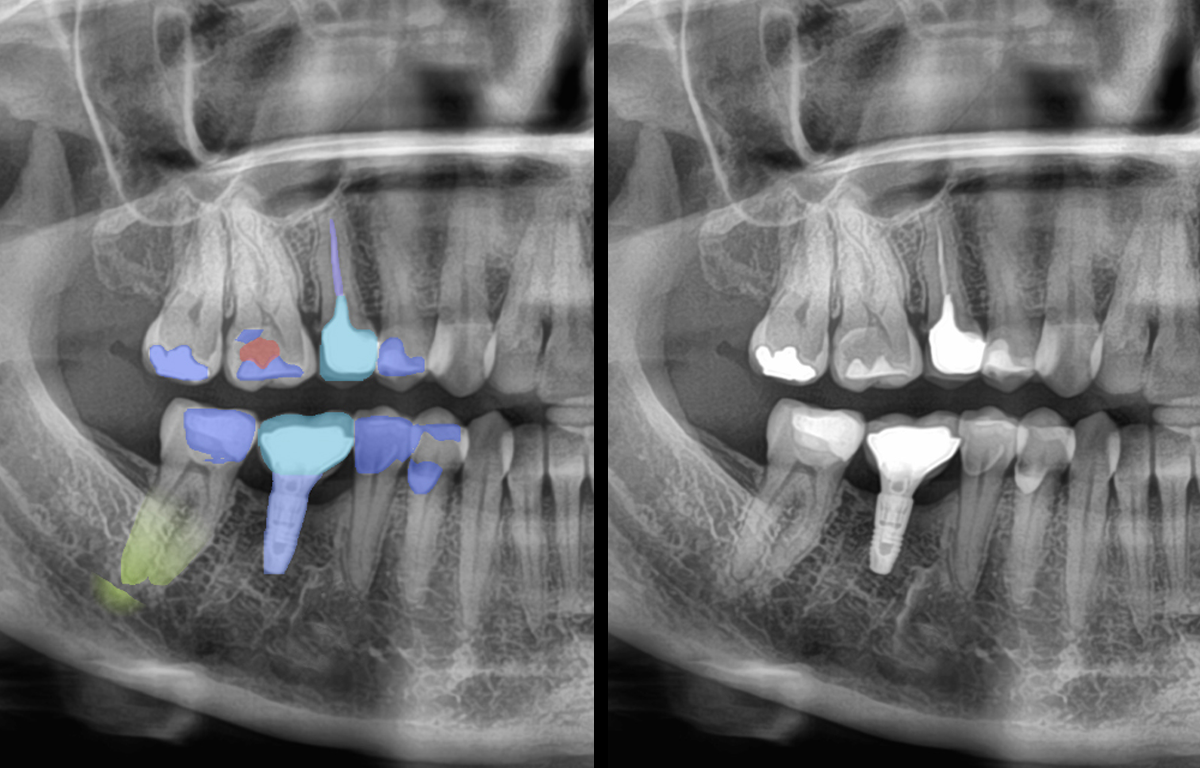Why dentists can trust AI in dentistry

Explainable Artificial Intelligence (XAI)” in dentistry
Oral and dental diseases incur costs of hundreds of billions of US dollars every year. In the future, treatment needs will continue to increase and so will the costs. This is particularly problematic because capacities are often insufficient and healthcare systems worldwide are frequently overburdened. Artificial intelligence can be part of the solution. But for the most part, there is still mistrust towards AI in dentistry. Questions like the following come up frequently:
- How accurate are AI results?
- Can I rely on AI as a dentist?
- What can AI detect and how do I profit?
- Could AI replace me at some point?
It is certainly difficult for a dentist who is not familiar with artificial intelligence to trust it “blindly”. A first step would be to learn more about the basic functionality of AI. After all, trust is built on an understanding of how AI works. However, the complexity of the results and approach often undermines the acceptance and use of artificial intelligence. The solution: Explainable Artificial Intelligence (XAI).
XAI is currently a rapidly growing field of research. It allows people to understand how artificial intelligence works and how to evaluate its results in terms of accuracy. AI models in dentistry are expected to use the same methods for detection and analysis as dentists while also generating faster and more accurate results. This identical approach to problems can create trust. The above-mentioned paper refers to a study showing how AI-driven decision-making can be analyzed using XAI.
This study is about the detection of carious lesions and uses 834 images of 56 patients from the database of the renowned Charité University Hospital in Berlin. These images were evaluated by three experienced dentists and a master reviewer. The result: 44% of the images contained carious lesions and 56% contained none. Subsequently, an AI was trained with these images and results. In this process, corresponding numerical values were assigned to the detections (0 = no caries, 1 = caries).
In some cases, results were close to 1.0 but in others, they were 0.29 or 0.11. At first glance, the AI seemed to provide unreliable results.
However, these were difficult cases that posed a real challenge even for dentists. Thus, the AI-based results only indicated the probability of an image showing carious lesions.
The study, therefore, showed that AI can certainly assist in dentistry. However, experienced dentists should be consulted in difficult cases. Artificial intelligence can thus be used for more efficient presorting and it can be particularly helpful for inexperienced dentists as a second opinion. All this saves an enormous amount of time.
Standardization in the field of AI
Why is standardization important? Standardized processes provide certain framework conditions to make sure that researchers adhere to the same qualitative and quantitative criteria. Especially in newer research areas, this is a challenge. Researchers often have different ideas about approaches and processes. That is why organizations need to set appropriate standards. In the field of artificial intelligence, these include:
- International Organization for Standards (ISO)
- International Electrotechnical Commission (IEC)
- International Telecommunication Union (ITU)
ITU has several study groups working on artificial intelligence in healthcare. There is even a specialized focus group that deals with dental diagnostics and digital dentistry. ISO and IEC have a joint standardization committee that focuses exclusively on standardization in the field of AI. The German Institute for Standardization (DIN) has also already defined a software development life cycle standard (the process of software development for providing software to the customer) in the medical field.
But what criteria are used for such standardization processes? The European Commission has defined seven basic requirements: human agency and oversight; technical robustness and safety; privacy and data governance; transparency; diversity, non-discrimination, and fairness; societal and environmental well-being; and accountability.
Conclusion
The research field of AI in dentistry still offers much potential for further development. Experts and organizations must work closely together to develop standards that create uniform quality criteria. XAI is an important field of research to build trust towards artificial intelligence and to increase its acceptance by medical professionals and society. In addition, XAI provides a basis for constantly refining and improving the way AI works. Only in this way can high-quality tools, such as the dentalXrai Pro software, be developed to actively support dentists in their everyday practice by optimizing processes.
We look forward to introducing dentalXrai to you!
Learn about our AI solutions for dental professionals
Please contact us if you want to learn more? We would be happy to present the AI-based software device to you in detail.
- Automated processes for more efficiency
- Time-savings in reporting
- Color coded detections for communications